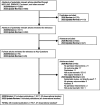Interventions to Optimize Spinal Cord Perfusion in Patients With Acute Traumatic Spinal Cord Injury: An Updated Systematic Review
- PMID: 38526931
- PMCID: PMC10964891
- DOI: 10.1177/21925682231218737
Interventions to Optimize Spinal Cord Perfusion in Patients With Acute Traumatic Spinal Cord Injury: An Updated Systematic Review
Abstract
Study design: Systematic review update.
Objectives: Interventions that aim to optimize spinal cord perfusion are thought to play an important role in minimizing secondary ischemic damage and improving outcomes in patients with acute traumatic spinal cord injuries (SCIs). However, exactly how to optimize spinal cord perfusion and enhance neurologic recovery remains controversial. We performed an update of a recent systematic review (Evaniew et al, J. Neurotrauma 2020) to evaluate the effects of Mean Arterial Pressure (MAP) support or Spinal Cord Perfusion Pressure (SCPP) support on neurological recovery and rates of adverse events among patients with acute traumatic SCI.
Methods: We searched PubMed/MEDLINE, EMBASE and ClinicalTrials.gov for new published reports. Two reviewers independently screened articles, extracted data, and evaluated risk of bias. We implemented the Grades of Recommendation, Assessment, Development, and Evaluation (GRADE) approach to rate confidence in the quality of the evidence.
Results: From 569 potentially relevant new citations since 2019, we identified 9 new studies for inclusion, which were combined with 19 studies from a prior review to give a total of 28 studies. According to low or very low quality evidence, the effect of MAP support on neurological recovery is uncertain, and increased SCPP may be associated with improved neurological recovery. Both approaches may involve risks for specific adverse events, but the importance of these adverse events to patients remains unclear. Very low quality evidence failed to yield reliable guidance about particular monitoring techniques, perfusion ranges, pharmacological agents, or durations of treatment.
Conclusions: This update provides an evidence base to support the development of a new clinical practice guideline for the hemodynamic management of patients with acute traumatic SCI. While avoidance of hypotension and maintenance of spinal cord perfusion are important principles in the management of an acute SCI, the literature does not provide high quality evidence in support of a particular protocol. Further prospective, controlled research studies with objective validated outcome assessments are required to examine interventions to optimize spinal cord perfusion in this setting.
Keywords: cervical; spinal cord injury; trauma.
Conflict of interest statement
Declaration of Conflicting InterestsThe author(s) declared no potential conflicts of interest with respect to the research, authorship, and/or publication of this article.
Figures

Similar articles
-
A Clinical Practice Guideline for the Management of Patients With Acute Spinal Cord Injury: Recommendations on Hemodynamic Management.Global Spine J. 2024 Mar;14(3_suppl):187S-211S. doi: 10.1177/21925682231202348. Global Spine J. 2024. PMID: 38526923 Free PMC article.
-
Interventions to Optimize Spinal Cord Perfusion in Patients with Acute Traumatic Spinal Cord Injuries: A Systematic Review.J Neurotrauma. 2020 May 1;37(9):1127-1139. doi: 10.1089/neu.2019.6844. Epub 2020 Mar 11. J Neurotrauma. 2020. PMID: 32024432
-
Multimodal interventions to optimize spinal cord perfusion in patients with acute traumatic spinal cord injuries: a systematic review.J Neurosurg Spine. 2022 Jun 3;37(5):729-739. doi: 10.3171/2022.4.SPINE211434. Print 2022 Nov 1. J Neurosurg Spine. 2022. PMID: 35901776 Review.
-
Significance of spinal cord perfusion pressure following spinal cord injury: A systematic scoping review.J Clin Orthop Trauma. 2022 Sep 11;34:102024. doi: 10.1016/j.jcot.2022.102024. eCollection 2022 Nov. J Clin Orthop Trauma. 2022. PMID: 36147378 Free PMC article. Review.
-
Folic acid supplementation and malaria susceptibility and severity among people taking antifolate antimalarial drugs in endemic areas.Cochrane Database Syst Rev. 2022 Feb 1;2(2022):CD014217. doi: 10.1002/14651858.CD014217. Cochrane Database Syst Rev. 2022. PMID: 36321557 Free PMC article.
Cited by
-
Critical Care of Spinal Cord Injury.Curr Neurol Neurosci Rep. 2024 Sep;24(9):355-363. doi: 10.1007/s11910-024-01357-8. Epub 2024 Jul 15. Curr Neurol Neurosci Rep. 2024. PMID: 39008022 Review.
-
Adherence to international guidelines in neurocritical care of cervical traumatic spinal cord injury-a retrospective study.Brain Spine. 2024 Apr 21;4:102821. doi: 10.1016/j.bas.2024.102821. eCollection 2024. Brain Spine. 2024. PMID: 38721265 Free PMC article.
-
AO Spine/Praxis Clinical Practice Guidelines for the Management of Acute Spinal Cord Injury: An Introduction to a Focus Issue.Global Spine J. 2024 Mar;14(3_suppl):5S-9S. doi: 10.1177/21925682231189928. Global Spine J. 2024. PMID: 38526930 Free PMC article.
-
A Clinical Practice Guideline for the Management of Patients With Acute Spinal Cord Injury: Recommendations on Hemodynamic Management.Global Spine J. 2024 Mar;14(3_suppl):187S-211S. doi: 10.1177/21925682231202348. Global Spine J. 2024. PMID: 38526923 Free PMC article.
-
Recent trends in spinal trauma management and research.J Clin Orthop Trauma. 2024 Jan 27;49:102351. doi: 10.1016/j.jcot.2024.102351. eCollection 2024 Feb. J Clin Orthop Trauma. 2024. PMID: 38333744 No abstract available.
References
-
- Evaniew N, Mazlouman SJ, Belley-Côté EP, Jacobs WB, Kwon BK. Interventions to optimize spinal cord perfusion in patients with acute traumatic spinal cord injuries: a systematic review. J Neurotrauma. 2020;37(9):1127-1139. - PubMed
-
- Tator CH, Fehlings MG. Review of the secondary injury theory of acute spinal cord trauma with emphasis on vascular mechanisms. J Neurosurg. Jul. 1991;75(1):15-26. - PubMed
-
- Ahuja CS, Wilson JR, Nori S, et al. Traumatic spinal cord injury. Nat Rev Dis Primers. 2017;3:17018. - PubMed
-
- Ryken TC, Hurlbert RJ, Hadley MN, et al. The acute cardiopulmonary management of patients with cervical spinal cord injuries. Neurosurgery. 2013;72(Suppl 2):84-92. - PubMed
-
- Saadeh YS, Smith BW, Joseph JR, et al. The impact of blood pressure management after spinal cord injury: a systematic review of the literature. Neurosurg Focus. 2017;43(5):E20. - PubMed
LinkOut - more resources
Full Text Sources

